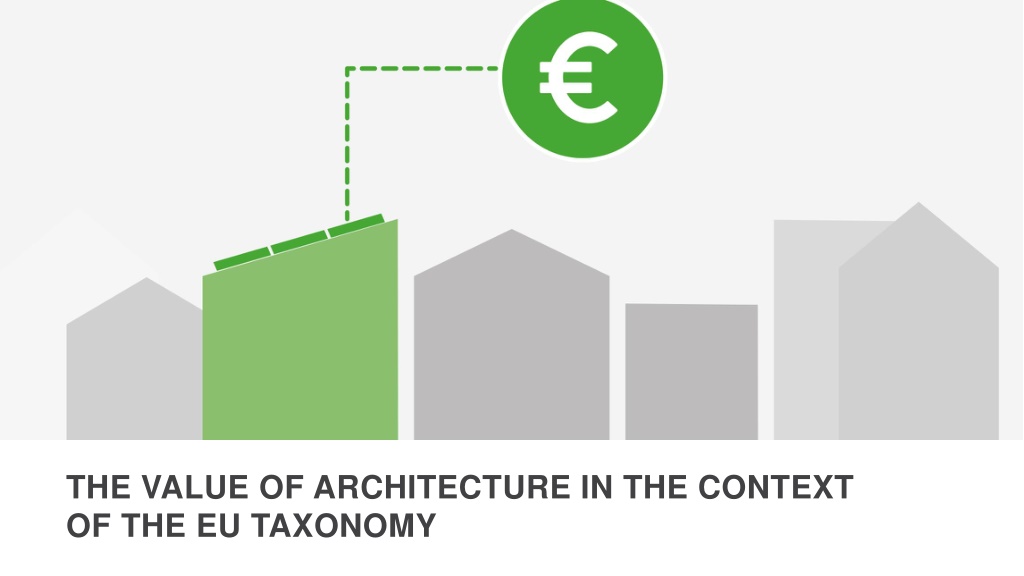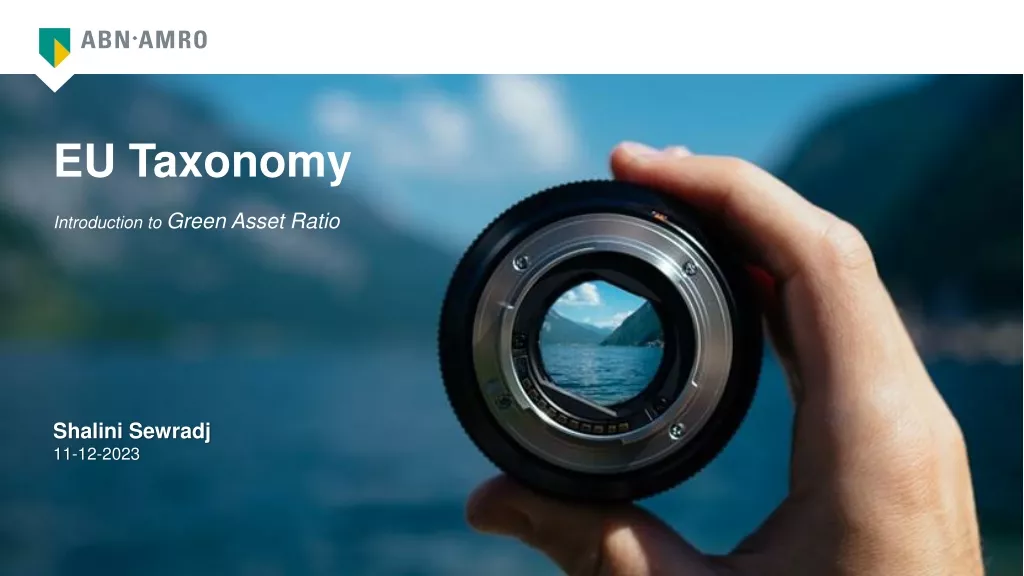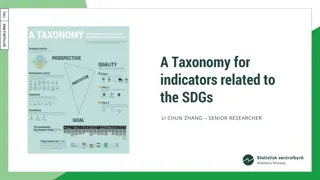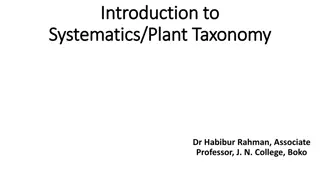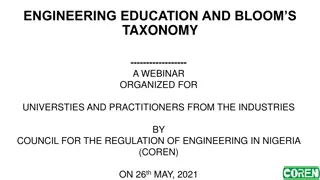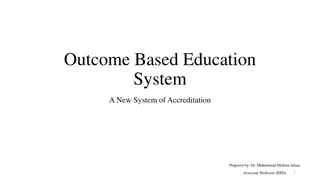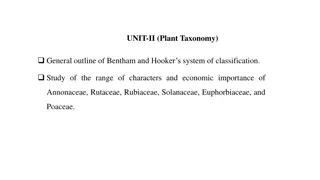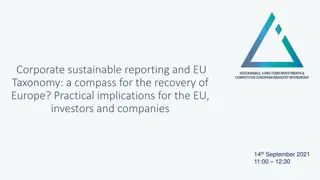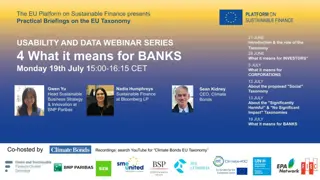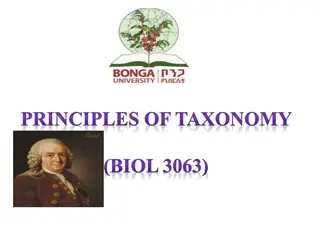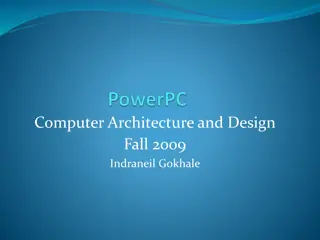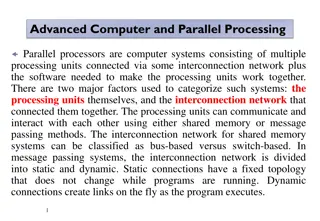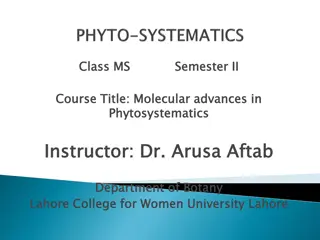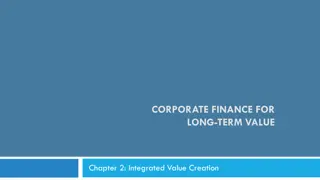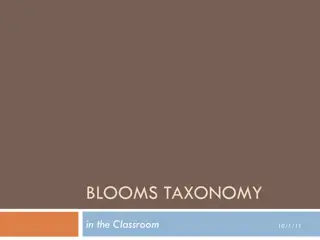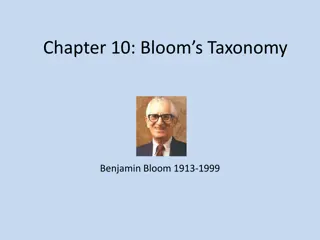THE VALUE OF ARCHITECTURE IN THE CONTEXT OF THE EU TAXONOMY
In the context of the EU Taxonomy, this presentation delves into how it creates avenues for sustainable architectural design, aligning design elements with Taxonomy criteria. It explores the European Green Deal, the need for sustainable finance strategies, and the relevance of the Taxonomy in classifying business activities for sustainability. The content emphasizes the pivotal role of the built environment in achieving a low-carbon economy and the significant investments required for a Paris-conformant European economy.
Download Presentation

Please find below an Image/Link to download the presentation.
The content on the website is provided AS IS for your information and personal use only. It may not be sold, licensed, or shared on other websites without obtaining consent from the author.If you encounter any issues during the download, it is possible that the publisher has removed the file from their server.
You are allowed to download the files provided on this website for personal or commercial use, subject to the condition that they are used lawfully. All files are the property of their respective owners.
The content on the website is provided AS IS for your information and personal use only. It may not be sold, licensed, or shared on other websites without obtaining consent from the author.
E N D
Presentation Transcript
THE VALUE OF ARCHITECTURE IN THE CONTEXT OF THE EU TAXONOMY
ABSTRACT In order to capitalise on the opportunities the EU Taxonomy offers for built environment professionals, this slide deck explains the EU Taxonomy and shows how it creates opportunities for sustainable architectural design, mapping design elements against existing Taxonomy criteria. Slide 2 of 31
TABLE OF CONTENTS European regulatory context Taxonomy relevance Taxonomy compliance through the building lifecycle Increasing value for all stakeholders Outlook sustainable finance Glossary Slide 3 of 31
The European Green Deal is the Commissions response to tackle environmental challenges. It aims to transform Europe's economy into a modern, resource-efficient and competitive one. THE EU GREEN DEAL AIMS TO TRANSFORM EUROPE'S ECONOMY INTO A MODERN, RESOURCE-EFFICIENT AND COMPETITIVE ONE. Building and real estate are crucial for the successful transition to a low-carbon economy, as they represent 40% of global energy consumption and are responsible for about the same amount of greenhouse gas emissions. In order to stay on a global warming path well below 2 C, buildings-related emissions need to decrease significantly. Slide 4 of 31
For the transformation to a Paris-conformant European economy, approximately 175bn 290bn annual investments are required until 2050, according to EU Commissioner Miguel Arias Ca ete (2018). It is private investors who are going to have to cover the lion s share of these investments. EUROPEAN SUSTAINABLE FINANCE STRATEGY Accordingly, the European Sustainable Finance Strategy, derived from the EU Sustainable Finance Action Plan, sets objectives to: massively increase sustainable investments define the qualities of sustainable investments Enabling companies to have access to green financing options by standardising reporting requirements to reflect sustainability risks and integrate them in the risk management of banks. It is hoped that the taxonomy will play a key role in ensuring that both public and private investments delivering the economic recovery from the COVID19-pandemic, will ensure resilience and sustainability. Slide 5 of 31
TAXONOMY RELEVANCE Recent years have seen a significant rise in investments that carry the adjectives green , sustainable , or ESG (products considering environmental, social and governance aspects) in the name. However, until very recently, there were no principles and metrics for the assessment of the sustainability of economic activities. The Taxonomy Regulation aims to classify business activities for their sustainability. Both financial market participants and larger businesses will have to be conformant with the taxonomy require- ments from 2022 onwards, in order to classify their activities as sustainable. Slide 6 of 31
The Taxonomy Regulation will set technical requirements for six set environmental objectives*: EU TAXONOMY: THE ENVIRONMENTAL OBJECTIVES 1. CLIMATE CHANGE MITIGATION 2. CLIMATE CHANGE ADAPTATION 3. WATER 4. CIRCULAR ECONOMY 5. POLLUTION 6. BIODIVERSITY * As of October, 2021 the technical requirements for Climate Change Mitigation and Climate Change Adaptation have been defined. The technical requirements for the other four environmental objectives are partly available as a draft. Slide 7 of 31
EU TAXONOMY: ENSURING TAXONOMY COMPLIANCE Significantly contribute to one environmental objective + Do No Significant Harm (DSNH) Criteria for all five other environmental objectives + Note: For Taxonomy compliance one must choose to contribute significantly to one environmental objective, while also complying with all the defined Do No Significant Harm criteria for the other environmental objectives and the minimum safeguard requirements. Minimum Requirements ensuring social safeguards Slide 8 of 31
TAXONOMY RELEVANCE As of October, 2021, the taxonomy has defined the technical requirements for Climate Change Mitigation and Climate Change Adaptation. For buildings, these requirements encompass the following business activities: New Construction Acquisition & Ownership Individual Measures Renovation Slide 9 of 31
The following graph illustrates how the Taxonomy requirements of significantly contributing to climate change mitigation influences different stages of the building lifecycle. CCM: Climate Change Mitigation CCA: Climate Change Adaptation CE: Circular Economy No Requirements Low Requirements Medium Requirements Slide 10 of 31 High Requirements
Project developers and building owners will be driven by the investment gap and the EU s Sustainable Finance Regulations to ensure that projects are resilient and have minimised risks for accessing green financing. Accordingly, the demand for Taxonomy eligible assets is expected to increase. WHY IS THE TAXONOMY RELEVANT FOR ARCHITECTS? Consequently, designing Taxonomy conformant buildings will create more value for those clients, who must comply to the regulation. As an architect, you can significantly influence the early stages of the building lifecycle. To ensure information on design features is not lost between designing and commissioning of the building, you could ensure that knowledge is transferred so that the buildings circularity and sustainability potential is utilised. Slide 11 of 31
INFLUENCING TAXONOMY COMPLIANCE THROUGH THE BUILDING LIFECYCLE Planning/Design Renovation Construction The following slides will depict the existing Taxonomy requirements applicable during the building s lifecycle and show how architects can ensure and influence compliance through the design. Building in use Demolition/ Wrecking ARCHITECT S INFLUENCE
TAXONOMY REQUIREMENTS PLANNING Mitigate climate change* Keep the primary energy demand 10% below NZEB# standard. Support circularity* Design buildings that are resource-efficient, adaptable, flexible, and dismantlable. Ensure sustainable use of water* Use water-saving appliances. Protect and restore biodiversity and ecosystems** Implement mitigation and compensation measures for protecting the environment identified in an EIA#. Adapt to Climate Change* Depending on the project site, ensure to design resilient buildings according to the identified climate risks. Slide 13 of 31 * Relevant for both, renovation and new construction #for details see Glossary at the end of the slide-deck **Only relevant for new construction
implement innovative energy concepts* and increase energy efficiency*, e.g. by optimising solar exposure with solar panels choosing a more compact design to minimise transmission connecting energy concepts on district level AS AN ARCHITECT YOU CAN increase flexibility and adaptability* of the building, which can be converted for different uses, e.g. by modular designing spaces minimising load-bearing and interior walls considering building depth and ceiling heights designing more communal spaces up-cycle materials recycling architecture on roofs and facades use bio-based materials avoid excess use of materials ..for more resource-efficiency* Slide 14 of 31 * Relevant for both, renovation and new construction
choose materials and their quality for increased dismantlability*. Favour assembling or other fixings high-quality finishing use of mono-materials favour water-saving appliances* and use innovative water concepts. AS AN ARCHITECT YOU CAN create ecological value** by improving the micro-climate. create diverse habitats and green spaces design the landscape by favouring indigenous flora and fauna design for resilience*, by adapting to today s and future local climate conditions: improve thermal comfort in outdoor spaces thereby improving micro-climate create multi-functional land use concepts, which encourage sustainable rain water management Slide 15 of 31 * Relevant for both, renovation and new construction **Only relevant for new construction
TAXONOMY REQUIREMENTS PROJECT SITE Adapt to Climate Change* Conduct a climate risk analysis of the site and vulnerability analysis of the building design Control pollution* Examine the construction site for contaminants Protect and restore biodiversity and ecosystems** Select project site which is not arable/crop land, forest or a greenfield land with high biodiversity value. Conduct an EIA or fulfill requirements of a conducted EIA and implement mitigation measures. Slide 16 of 31 * Relevant for both, renovation and new construction **Only relevant for new construction
screen the site for future climate scenarios* and consequently use autochthonous design. AS AN ARCHITECT YOU CAN commission a soil pollution analysis.** by preferring conversion of existing brownfield sites and underused areas and striving for higher density, you can protect existing ecosystems and ensure land use efficiency** Slide 17 of 31 * Relevant for both, renovation and new construction **Only relevant for new construction
TAXONOMY REQUIREMENTS BUILDING MATERIALS Mitigate climate change** Analyse the life cycle global warming potential of the building Prevent Pollution* The Taxonomy strictly regulates what type of materials can be used: limit formaldehyde and carcinogenic volatile organic compounds emissions Slide 18 of 31 * Relevant for both, renovation and new construction **Only relevant for new construction
optimise the life cycle global warming potential of the building** by using bio-based, upcycled, recycled and secondary raw materials. AS AN ARCHITECT YOU CAN Avoid using hazardous building materials and choose materials with the lowest possible environmental impact*. Slide 19 of 31 * Relevant for both, renovation and new construction **Only relevant for new construction
TAXONOMY REQUIREMENTS CONSTRUCTION SITE Protect water and marine resources** Identify risks from the construction site for maintaining water quality. Support circularity* Re-use and recycle at least 70% of the non- hazardous construction and demolition waste. Control pollution* Reduce noise, dust and pollutant emissions. Slide 20 of 31 * Relevant for both, renovation and new construction **Only relevant for new construction
choose materials which ensure that water and marine resources are protected. AS AN ARCHITECT YOU CAN Design for enabling reuse* of materials from previous construction on site Recycle* existing materials on site Use prefabricated elements to reduce noise and dust* Use constructive solutions*, which do not require glues/ foams Work with manufacturers / select solutions that do not generate dust, noise and pollutants** Slide 21 of 31 * Relevant for both, renovation and new construction **Only relevant for new construction
TAXONOMY REQUIREMENTS BUILDING AFTER COMPLETION Mitigate climate change: Ensure air tightness and conduct a thermography measurement. AS AN ARCHITECT YOU CAN You can prove your expertise and the quality of your detailed planning and quality assurance, showing that no mistakes were made during execution.** Slide 22 of 31 **Only relevant for new construction
ADVOCATE FOR MORE ACCOUNTABILITY Building and planning requires interconnected working and shared responsibilities. Therefore, while you can ensure that sustainability aspects derived from the Taxonomy are complied with, you can advocate for other building stakeholders and policy makers to be made accountable, too. Advocate for: more transparency regarding the environmental impact of building materials and more sustainable solutions from product manufacturers cities and municipalities to set up location-specific climate change adaptation plans and ensure land use efficiency when reclassifying areas Energy designers and building owners to calculate real life cycle costs of energy alternatives Slide 23 of 31
AN ARCHITECTS CONTRIBUTION Considering that stakeholders of the building sector are affected by the Taxonomy regulations, architects can support Taxonomy eligibility by adapting their designs. By increasing the know-how on the Taxonomy requirements, ensuring Taxonomy conformity in design, choosing eligible building materials and documenting all sustainability aspects for the Taxonomy, architects can ensure that established sustainability standards are met. Further they can also provide information required for standardised disclosure to enable comparability between different projects and deliver not only higher data quality required for documentation of compliance, but also for the closing of data gaps. Slide 24 of 31
INCREASING VALUE FOR INVESTORS Higher sales price Lower design and construction costs Improved risk management Quicker sales Reduced vacancy rates Investor Compliance with legislation and CSR requirements Ability to secure finance Rapid return on investment Corporate image and prestige value Better value preservation/potential Slide 25 of 31
INCREASING VALUE FOR USERS Health and well-being Increased productivity* (covered by future soc. Criteria) Compliance with legislation and CSR requirements User Corporate image and prestige value Lower operating costs Lower maintenance costs Slide 26 of 31
INCREASING VALUE FOR OWNERS Improved risk management Reduced vacancy rates Compliance with legislation and CSR requirements Corporate image and prestige value Ability to secure finance Rapid return on investment Lower operating costs Better value preservation/potential Lower maintenance costs Slower depreciation Increased occupancy rate Owner Slide 27 of 31
INCREASING VALUE FOR ALL STAKEHOLDERS Higher sales price Health and well-being Lower design and construction costs Improved risk management Increased productivity* (covered by future soc. Criteria) Quicker sales Reduced vacancy rates Investor User Compliance with legislation and CSR requirements Ability to secure finance Lower operating costs Corporate image and prestige value Rapid return on investment Lower maintenance costs Better value preservation/potential Slower depreciation Increased occupancy rate Owner Slide 28 of 31
As of October, 2021, the technical requirements for buildings are still to be defined for the remaining four environmental objectives OUTLOOK FOR SUSTAINABLE FINANCE AND ARCHITECTURE Water Circular Economy Pollution Biodiversity A draft for Circular Economy and Biodiversity is already available setting out further requirements for the building sector. These are to be applied by 2023. The project developer will then be able to choose to which environmental objective a significant contribution should be made. Furthermore, a social taxonomy may be introduced with the objective of contributing substantially to basic needs and infrastructure. Slide 29 of 31
GLOSSARY DNSH: Do No Significant Harm EIA: The Environmental Impact Assessment (EIA) is a procedure that ensures that environmental implications of decisions are considered for infrastructural projects. It provides high level of protection of the environment ESG: Environmental, Social, and Governance Environmental Objectives: The Taxonomy Regulation has defined six environmental objectives: (1) Climate change mitigation, (2) Climate change adaptation, (3) Sustainable use and protection of water and marine resources, (4) Transition to a circular economy, (5) Pollution prevention and control, (6) Protection and restoration of biodiversity and ecosystems NZEB: The European Energy performance of buildings directive (EPBD) requires all new buildings from 2021 to be nearly zero-energy buildings (NZEB). The EU countries nearly zero-energy building national plans can be found here. Slide 30 of 31
Written by Climate Positive Europe Alliance (CPEA) www.cpea.eu Seema Issar, Dr. Anna Braune, Dr. Christine Lemaitre, Ursula Hartenberger Publication Details Published in November 2021 by ACE Architects' Council of Europe The European Commission support for the production of this publication does not constitute an endorsement of the contents which reflects the views only of the authors and the Commission cannot be held responsible for any use which may be made of the information contained therein.
